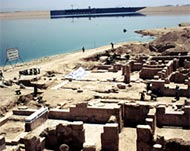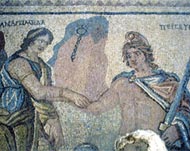Clashes over treasures of Zeugma
One of the greatest collections of ancient mosaics anywhere in the world has caused controversy in Turkey – 1700 years after they were created.

Disputes surround dozens of Roman masterpieces unearthed from the ancient city of Zeugma in southern Turkey.
Archaeologist Richard Hodges has told Aljazeera.net of a tragic excavation.
“At every stage of our work here, we have been met with the most torturous obstacles.”
Bitter disputes over what to do with the mosaics – and who is responsible for their current condition – have led to the collapse of archaeological work on the site.
Meanwhile, the public has been unable to view these fantastic objects, as officials have argued over their fate.
Site history
Back in 2000, French and Turkish archaeological teams working at Zeugma – which lies on the banks of the River Euphrates, just north of the town of Birecik – uncovered a set of spectacular 3rd century mosaics.
This was just days before the site was due to be flooded by a new dam.
Responding to this crisis, the US-based David Packard Trust hired Richard Hodges’ UK-based Oxford Archaeology Unit to undertake emergency excavation.
|
“At Zeugma we have the chance to excavate and restore mosaics of the quality and size of Antioch but using the very best modern methods” Richard Hodges, |
Working on the site during 2000, the Unit uncovered many more mosaics and artefacts and worked using satellite imaging to uncover more of the ancient city’s ground plan.
They also hired Italian restoration expert Roberto Nardi to work on the mosaics and frescoes that had already been uncovered by the Turkish and French teams. These had been deposited at the local archaeology museum in Gaziantep.
“The mosaics were in a deplorable state in May 2000,” Hodges says. “For the record, you could say in a catastrophic state.”
Nardi moved into a purpose built laboratory behind the museum and began work. Yet the troubles for the excavation were only just beginning.
Flooded
“The water has now reached its final level,” says Mehmet Onal from Gaziantep museum and one of the original excavators of Zeugma.
“While a quarter of the mosaics are underwater, most were rescued. We’ve rescued more than 1000 square metres of mosaics and 150 square metres of frescoes.”
Yet, as the floodwaters rose over the ancient city – eventually leaving 20% of this Roman frontier town under water – controversy also rose up around the rescued artefacts.
 |
|
20% of excavation site now |
Two bitter arguments have broken out over what to do with this remarkable collection.
“The Turkish government asked David Packard if the mosaics could be exhibited in Istanbul when the NATO summit is on next month,” explains Hodges.
“He reluctantly said fine. We wanted them to be on exhibit in Istanbul in a cheap, good quality way in which they could be seen by the maximum number of Turkish people.”
Protests
But the Turkish government’s plans to move them away from Gaziantep have been met with anger, hostility and legal action by locals.
“The mosaics are, according to the law, immovable culture heritage,” lawyer Dilek Topalkara of the citizens’ group Zeugma Platform told Aljazeera.net.
“According to expert reports, both during the packaging and moving operations they will be damaged … even during the packaging many pieces have been damaged. If they were moved, they would be damaged both because of shaking during the journey and because of the climate change.”
The Platform has tried to prevent the mosaics from being taken via a series of court rulings.
However, the Gaziantep high court ruled Monday to overturn previous decisions and decided instead that the Platform had no right to prevent the mosaics from being taken to Istanbul.
Shoddy workmanship?
Meanwhile, there have also been allegations against Roberto Nardi over his restoration work. However, the local court ruled that he did not have a case to answer earlier this week.
“We hired him because, if you ask anyone in archaeology who is the best person for restoring mosaics, they will all say Roberto Nardi,” Hodges says.
 |
|
Andromeda features in one of the |
Meanwhile, until late May, Gaziantep museum – which is run by the government’s culture ministry – had itself been closed, with none of the mosaics on view to the public.
“This shows that there is something going on here that is about more than just exhibiting the mosaics,” says Topalkara.
Locals fear that the museum’s closure is part of a campaign to pressure them into releasing the mosaics elsewhere – and that once they have left town, they will never return.
Tight lipped
Museum authorities refused to comment on the case to Aljazeera.net, with museum director Hamza Gulluce saying “the subject is far too hot at the moment”.
“For reasons best known to themselves,” says Hodges, “the local authorities have been making everything about this so difficult.”
Finally, at the end of May, the court in Gaziantep ordered the museum to reopen and the mosaics to be displayed. Now, experts are examining the mosaics to determine just how feasible that is.
Everyone agrees, however, on the great value of the finds at Zeugma.
Artefacts found
“There are basically two great collections of mosaics in the world,” says Hodges.
“One is at the Bardo museum in Tunis and the other is in Antakya – ancient Antioch – in Turkey. The latter wasn’t excavated very well, but here at Zeugma we have the chance to excavate and restore mosaics of the quality and size of Antioch but using the very best modern methods.
|
“At every stage of our work here, we have been met with the most torturous obstacles” Richard Hodges, |
“These have lain under the ground without being touched or damaged since the day in 253 AD when the city was destroyed by the army of Shapur I of Persia.”
Now, the hope is that at least some of these great artefacts will go on exhibit in Gaziantep, even if nowhere else.
“We want a mosaic museum to be built and the pieces to be exhibited here,” says Topalkara, “and archaeological research to be carried on at Zeugma.”
But although Onal and his team continue to work on one of the city’s villas, there seems little chance of any more major archaeological digging.
“We have no plans to continue our work there,” says Hodges, “because it’s so difficult. It’s a real shame, as the site is full of promise. Three quarters of it remains above the water line to be investigated. I just hope that soon what has been uncovered can be displayed for the benefit of the Turkish people.”